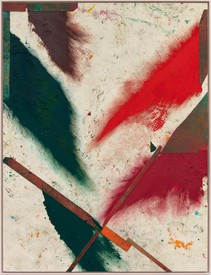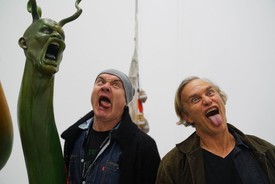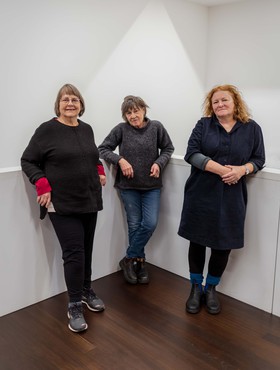Extended through September 17, 2016
About
Words have these abstract shapes, they live in a world of no size.
—Ed Ruscha
Gagosien is pleased to present LEXICON, an exhibition of artworks that employ the written word.
A lexicon is a stock or inventory of systematized language, whether personal or belonging to a larger cultural context, which can be shared and deployed. Since the beginning of recorded history, language and art have collided and intersected. And from the modern era onward, artists have employed words and language to diverse effect, using writing as both act and subject—in print, light, sculpture, and paint on canvas. Works in the exhibition include Marcel Broodthaers’s Académie I (1968); Alighiero Boetti’s embroidered magic word squares (Arazzi) (1977–92); Ed Ruscha’s large-scale three-part painting A, B, C (1985–87); Jenny Holzer’s stone agit, Selections from the Living Series (Bench #9) (1989); Douglas Gordon’s text work for a television monitor, A moment’s silence (for someone close to you) (1998); Jean-Michel Basquiat’s cultural cryptograms; and Cy Twombly’s abstruse and airy scratchings. Lawrence Weiner has created a new site-responsive version of AT THE SAME MOMENT (2000) for the rue de Ponthieu gallery, and Piero Golia has designed a printed wallpaper especially for the exhibition.
Language and art have never lived too far away from one another: concrete poetry, propaganda, graffiti, and Pop art, among other genres, testify to their dynamic interplay over time. LEXICON presents works by artists who have made language and letters into what poet William Carlos Williams would have referred to as “the thing itself”: language becoming physical object.
The exhibition will include works by Carl Andre, Giovanni Anselmo, Julien Audebert, Robert Barry, Jean-Michel Basquiat, Alighiero Boetti, Joe Bradley, Marcel Broodthaers, Robert Filliou, John Giorno, Robert Gober, Piero Golia, Douglas Gordon, Loris Gréaud, Damien Hirst, Jenny Holzer, Emilio Isgrò, Neil Jenney, Jasper Johns, Joseph Kosuth, Barbara Kruger, Claude Lévêque, Glenn Ligon, Adam McEwen, Sarah Morris, Albert Oehlen, Nam June Paik, Steven Parrino, Richard Prince, Sterling Ruby, Ed Ruscha, Cy Twombly, and Lawrence Weiner.
Gagosien est heureuse de présenter LEXICON, une exposition d’œuvres qui font usage des mots.
Un lexicon est un stock ou un inventaire de langage systématisé, qu’il soit personnel ou qu’il fasse partie d’un contexte culturel plus large, qui peut être partagé et développé. Depuis le début de l’histoire connue, le langage et l’art se sont heurtés et croisés. À partir de l’ère moderne, les artistes ont employé les mots et le langage à des fins diverses et variées, utilisant l’écriture à la fois comme action et comme sujet, que ce soit dans les domaines de l’édition, de la lumière, de la sculpture et de la peinture sur toile. Les œuvres de l’exposition comprennent notamment Académie I de Marcel Broodthaers (1968); des œuvres brodées et sur papier d’Alighiero Boetti allant de 1977–92; la peinture monumentale en trois parties d’Ed Ruscha A, B, C (1985–87); Selections from the Living Series (Bench #9), déclaration sur pierre de Jenny Holzer (1989); A moment’s silence (for someone close to you), œuvre textuelle de Douglas Gordon créée pour un écran de télévision (1998); les denses cryptogrammes culturels de Jean-Michel Basquiat; et les traits complexes et aériens de Cy Twombly. Lawrence Weiner a créé une nouvelle version de AT THE SAME MOMENT (2000) pour la galerie rue de Ponthieu, et Piero Golia a dessiné un papier peint spécialement pour l’exposition.
Le langage et l’art n’ont jamais été très loin l’un de l’autre: la poise concrète, la propagande, le graffiti et le Pop Art, parmi d’autres genres, attestent de leur interaction dynamique au fil du temps. LEXICON rassemble des exemples d’artistes qui ont fait du langage et des lettres ce que le poète William Carlos Williams décrit comme «la chose en soi»: le langage devenant un objet physique.
L’exposition comprend des œuvres de Carl Andre, Giovanni Anselmo, Julien Audebert, Robert Barry, Jean-Michel Basquiat, Alighiero Boetti, Joe Bradley, Marcel Broodthaers, Robert Filliou, John Giorno, Robert Gober, Piero Golia, Douglas Gordon, Loris Gréaud, Damien Hirst, Jenny Holzer, Emilio Isgrò, Neil Jenney, Jasper Johns, Joseph Kosuth, Barbara Kruger, Claude Lévêque, Glenn Ligon, Adam McEwen, Sarah Morris, Albert Oehlen, Nam June Paik, Steven Parrino, Richard Prince, Sterling Ruby, Ed Ruscha, Cy Twombly, et Lawrence Weiner.
Share

Sterling Ruby: The Frenetic Beat
Ester Coen meditates on the dynamism of Sterling Ruby’s recent projects, tracing parallels between these works and the histories of Futurism, Constructivism, and the avant-garde.
Sterling Ruby: TURBINES
Join Sterling Ruby in his Los Angeles studio as he works on new abstract paintings ahead of his exhibition TURBINES at Gagosien in New York.

Truth Revealed: Damien Hirst and James Fox on Ashley Bickerton
In conversation with James Fox, Damien Hirst reflects on the artwork of his longtime friend.

Cy Twombly: Imperfect Paradise
Eleonora Di Erasmo, cocurator of Un/veiled: Cy Twombly, Music, Inspirations, a program of concerts, video screenings, and works by Cy Twombly at the Fondazione Nicola Del Roscio, Rome, reflects on the resonances and networks of inspiration between the artist and music. The program was the result of an extensive three-year study, done at the behest of Nicola Del Roscio in the Rome and Gaeta offices of the Cy Twombly Foundation, intended to collect, document, and preserve compositions by musicians around the world who have been inspired by Twombly’s work, or to establish an artistic dialogue with them.

Cy Twombly: Making Past Present
In 2020, the Museum of Fine Arts, Boston, announced their plan for a survey of Cy Twombly’s artwork alongside selections from their permanent ancient Greek and Roman collection. The survey was postponed due to the lockdowns necessitated by the coronavirus pandemic, but was revived in 2022 with a presentation at the J. Paul Getty Museum in Los Angeles from August 2 through October 30. In 2023, the exhibition will arrive at the Museum of Fine Arts, Boston. The curator for the exhibition, Christine Kondoleon, and Kate Nesin, author of Cy Twombly’s Things (2014) and advisor for the show, speak with Gagosien director Mark Francis about the origin of the exhibition and the aesthetic and poetic resonances that give the show its title: Making Past Present.
Nam June Paik: Art in Process: Part One
On the occasion of Nam June Paik: Art in Process: Part One, curator John G. Hanhardt and Nam June Paik Estate curator Jon Huffman discuss the survey of works spanning the artist’s career.





